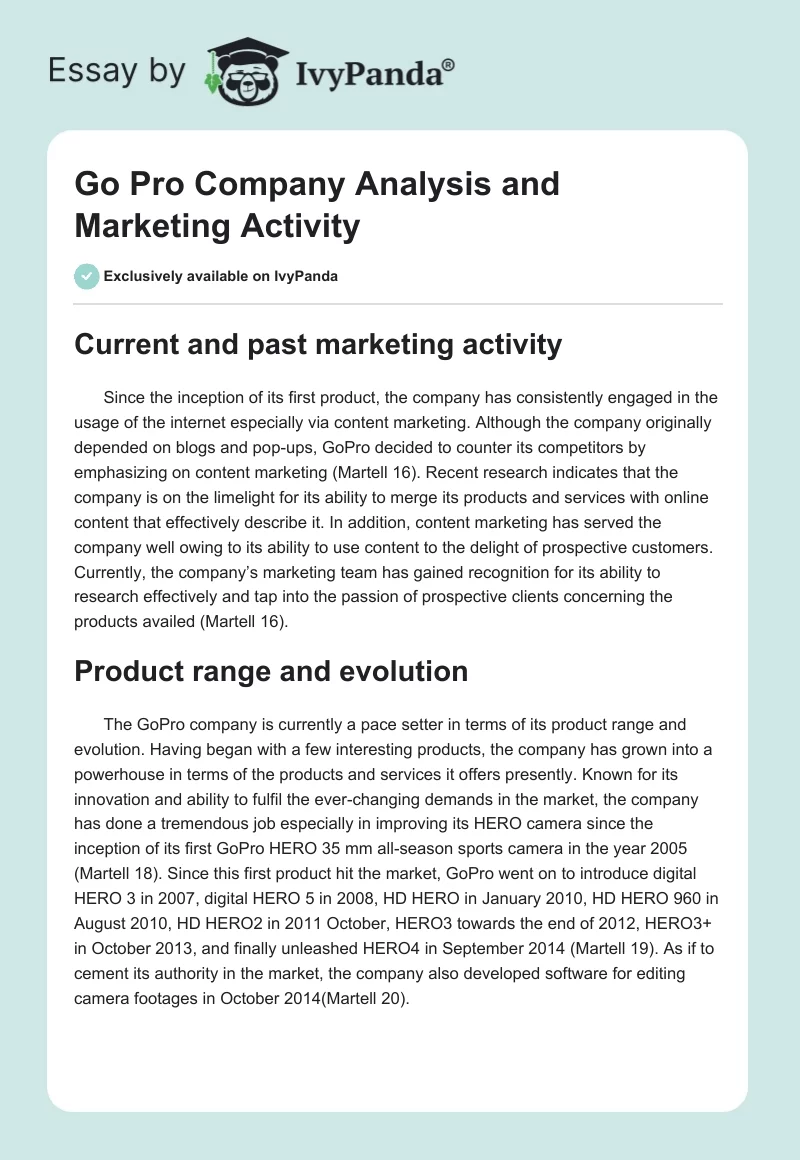Current and past marketing activity
Since the inception of its first product, the company has consistently engaged in the usage of the internet especially via content marketing. Although the company originally depended on blogs and pop-ups, GoPro decided to counter its competitors by emphasizing on content marketing (Martell 16). Recent research indicates that the company is on the limelight for its ability to merge its products and services with online content that effectively describe it. In addition, content marketing has served the company well owing to its ability to use content to the delight of prospective customers. Currently, the company’s marketing team has gained recognition for its ability to research effectively and tap into the passion of prospective clients concerning the products availed (Martell 16).
Product range and evolution
The GoPro company is currently a pace setter in terms of its product range and evolution. Having began with a few interesting products, the company has grown into a powerhouse in terms of the products and services it offers presently. Known for its innovation and ability to fulfil the ever-changing demands in the market, the company has done a tremendous job especially in improving its HERO camera since the inception of its first GoPro HERO 35 mm all-season sports camera in the year 2005 (Martell 18). Since this first product hit the market, GoPro went on to introduce digital HERO 3 in 2007, digital HERO 5 in 2008, HD HERO in January 2010, HD HERO 960 in August 2010, HD HERO2 in 2011 October, HERO3 towards the end of 2012, HERO3+ in October 2013, and finally unleashed HERO4 in September 2014 (Martell 19). As if to cement its authority in the market, the company also developed software for editing camera footages in October 2014(Martell 20).
Competitive environment
Owing to the fact that GoPro operates in a technology driven industry, competition hits new echelons with the implementation of every innovative idea. This means that it runs within an extremely competitive environment. The two main competitors are Sony and Garmin (Martell 21). However, over the past few years Garmin seems to have lagged behind in terms of innovation. On the other hand, Sony has continued to mount pressure on GoPRo as is evident with the introduction of the Sony action Cam AS100V (Martell 22). For a while, it seemed like no players in the industry would ever match up to the speed and ease with which GoPro launched new products into the market. However, the new Sony AS100V correctly counters and matches the latest release by GoPro (GoPro HERO3+) and customers seem unable to choose between the two (Martell 23). This is a clear confirmation that competitiveness is at its highest.
Present dangers/threats
One of the present dangers facing the GoPro Company is the possibility of the leakage of innovative ideas to its competitors. After Sony launched their latest action Cam, it is clear that information within GoPro is not as secure as previously voiced out by the company’s executives (23). In addition, the company needs to grow in a mature market. The danger here is evident because as the company seeks to overcome challenges in order to grow in a mature market, the long-term effects of the company’s strain may end up damaging and diminishing its value as an entity (Martell 24).
Marketing recommendations
Bearing in mind the increasing competitiveness and probably the decreasing avenues of product improvement, GoPro should consider marketing its products in a different way. The best and most recommendable would be to try to reach out to a completely different customer base- the middle class by lowering the prices of the company’s previous camera versions and enticing the middle class by providing gifts or availing the cameras at more affordable prices.
Works Cited
Martell, Deborah. “Marketing and Information Technology.” European Journal of Marketing 1.5 (2014): 16-24. Print.


